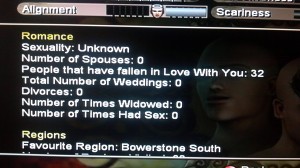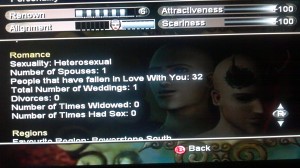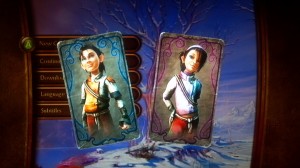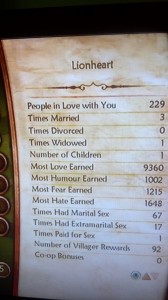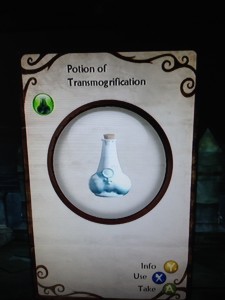Representations of non-normative genders and sexualities are nothing new in digital games. There are numerous examples (see also here), and many left to be recorded I’m sure. That said, the amount of diversity of sexualities and genders in this medium still seems lacking, particularly vis-à-vis other media. In the past I have written on the cultural production dynamics that help explain some of this relative lag in representation. Since writing that piece, there has been significantly more popular and academic attention to queer content in games, as I discuss here. When it comes to the politics of representation, however, more discussion has to happen that takes into account the particularities of the medium and does not rely on a problematic over-reliance on “realism” as the crux of the analysis. Here I use optional relationships and gender options in the game series Fable as a entry point into the complex dynamics of gender and sexuality in games as texts and structures.
It is pretty easy, but still vitally important, to point out the horrible transphobia in games like Grand Theft Auto V. This type of representation, and in turn its critique, recalls a long history of literature on the politics of representation (specifically Richard Dyer’s essay “Stereotyping”). Games are different from other media texts in key ways however. Espen Aarseth calls video games ergodic texts, which require nontrivial work in order for players/audiences to get through them.[i] Although there is a long history of debate between narratological approaches[ii] to games as cultural texts and the ludological approaches[iii] to games as rule-bound play spaces, I think it is fair to say that most (but certainly not all) games scholars would accept that we can talk about both at the same time and that each is important.[iv]
When it comes to analyzing representation in games, the interactive possibilities of the medium allows for a type of experience unavailable in most media: making the protagonist’s appearance and experience respond to player choices. Many digital games give players the opportunity to create their own avatars/characters[v], make moral choices for their on-screen proxy, engage in a variety of romantic pairings, and choose dialog options that change the flow of the text. This is particularly the case in the roleplaying genre of games (RPGs).[vi] Optional same-sex relationships in particular are one form of non-normative representation unique to this medium. Same-sex relationship options in games (not all of which are RPGs) like Bully, The Sims, The Temple of Elemental Evil, Mass Effect, and Dragon Age 2, are almost universally celebrated.
The Fable series in particular has drawn widespread acclaim for its portrayal of “diverse” sexualities (see here, here, and here). Yet, if we look at the changes to the structure of game choices over the course of the development of the Fable franchise, we actually see a persistent shutting down of queerness just as the game itself becomes more nuanced in terms of interactivity and narrative. Spoilers below.
In Fable I, the player-character can marry many men and women characters, and remain married to multiple partners of any gender. According to news articles on the game, this was the result of a coding error. All of the villagers in the game are programmed to be able to fall in love with the player-character (though it does still seem there are more female characters than male characters who fall for my male avatar). This makes same-sex romantic pairings possible but it does not reduce such pairings to identity labels. Although the non-player characters (NPCs) are not given sexuality labels, however, the player-character is marked in an oddly rigid way. Before my male character (the only option in the first game) marries anyone in the game, my character’s stat sheet lists his sexuality as “unknown.” When my male character marries a female villager, the stat sheet screen lists him as “heterosexual.” If I instead marry a male NPC the stats screen labels my character as “gay.” Notably, when I marry any female villager, I receive a dowry and a cut scene of the marriage, while if I marry a male villager there is no dowry and no cut scene. Whatever the gender of my first spouse, if I choose the opposite gender for my second spouse, my character’s label switches to “bisexual.” See images below for what these shifts actually looks like. Significantly, in the game, sexual practice and marriage are two separate actions, making it possible to marry one or more spouses and in turn change sexuality labels without ever even having sex! Indeed in Fable I you cannot have non-commercial sex until you are married, but you can employ the services of sex workers.
In Fable II, the rigid emphasis on labeling and clear distinction between identity categories shifts. Unlike in the first game, I can select a male or female character at the start of the game. Gender choice in games is almost always binary and collapses gender and sex into a single entity. Here when I discuss gender without distinguishing it from sex it is because performance (clothing, gait, etc.) is the only way the game communicates either, and often treats gender as sex (male and female). Interestingly, in the options of young characters you have at the start of Fable II there is not a great degree of gendered difference. The options are relatively androgynous and largely only marked as gendered by the blue and pink borders around the images and clothing colors (see below).
Moreover, whom my character has sex with or marries no longer results in a sexuality label in the stats screen. My character can also have sex with or without being married, via seduction of the right person, or by paying sex workers. There are separate stats for marital and extramarital sex however.
Non-player characters (NPCs), on the other hand, have specifically encoded sexualities in Fable II (in contrast to Fable I). The player can highlight and scan each NPC to pull up a screen that provides not only information on their personality and sexuality (either straight, gay, lesbian or bisexual), but what types of expressions you can perform and gifts you can give them to win them over. If only dating could be this easy in the rest of our lives!
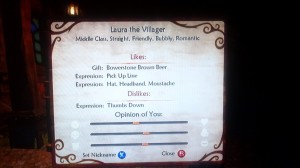 On the one hand the type of representation in Fable II is more realistic than that in Fable I, as not everyone is open to dating people of all genders. What is not realistic, and is quite problematic, is that any NPC whose sexuality marks them as potentially attracted to the player-character’s gender can fall in love with the character—in other words, all lesbian-and bisexual-coded female NPCs and all heterosexual-coded male NPCs can fall in love with my female character, and all gay- and bisexual-coded male NPCs and heterosexual-coded female NPCs can fall in love with my male character. Translating this into “real” life would imply that all lesbians and heterosexual men could fall in love with me if I am a female-identified person, and all bisexuals fall in love with everyone. I think I’m pretty likable, but that is on its face ridiculous.
On the one hand the type of representation in Fable II is more realistic than that in Fable I, as not everyone is open to dating people of all genders. What is not realistic, and is quite problematic, is that any NPC whose sexuality marks them as potentially attracted to the player-character’s gender can fall in love with the character—in other words, all lesbian-and bisexual-coded female NPCs and all heterosexual-coded male NPCs can fall in love with my female character, and all gay- and bisexual-coded male NPCs and heterosexual-coded female NPCs can fall in love with my male character. Translating this into “real” life would imply that all lesbians and heterosexual men could fall in love with me if I am a female-identified person, and all bisexuals fall in love with everyone. I think I’m pretty likable, but that is on its face ridiculous.
Arguments about realism, however, miss what is actually problematic about the way sexuality, sex, and gender are linked in the game. Specifically, a critical potential is lost when sexuality is treated as immutable, gender is a rigid binary that determines sexuality, and when fantasy is made “realistic” only when it comes to remarginalizing marginalized groups (non-heterosexual NPCs are few and far between in the game). Indeed in neither game is sexuality treated as flexible. Identity labels like straight and gay are reduced to the sex you have (or who you marry) or over-determine with whom one might have sex in the future. As we know, outside of the game many lesbians have had and continue to have sex with men, many straight men enjoy sex with other men, and many people of a variety of gender and sexuality identities end up attracted to and/or married to people they never would have dreamed of desiring at another point in their life. Further we can be critical of the fact that children, guards, enemies, and other NPCs you cannot seduce notably have no sexuality listed. According to the game, it would seem that children have no sexuality and that your sexuality only exists as it impacts me. Moreover, all sex workers in the game (male or female) are coded as bisexual, which reproduces a tired and oppressive stereotype about sex workers and bisexuals as those who will “screw anything that moves.” Further, it assumes that sex work is sex not work, and in turn defines one’s sexual identity.[vii]
Similarly in Fable II, while players can wear clothing designed for either of the two avatar gender options, the clothing is still clearly gendered. I can buy “Noble Lady’s Boots,” for example, from various clothing vendors or choose to outfit my avatar in female or male versions of the “Lower Class Outfit.” Clothing meant for the other gender can earn my character “crossdressing” stats and runs the risk of offending villagers: when I changed my male avatar’s outfit from the “Male Lower Class Outfit” to a corset, skirt, and “noble lady’s boots” (a mixture of class statuses but only one gender status), the tailor who owned the shop exclaimed “that is just disgusting!” However, a female villager I was wooing proclaimed me “radient!” when I made a similar costume change in front of her, and reacted negatively when I switched back to the male peasant outfit. As in life, apparently, transphobia is not the automatic response of the NPCs. Regardless, male characters in dresses and female characters in male-coded pants are always labelled as “cross-dressing” and never merely men in dresses or women in pants. Essentially, gender identity in the game (which is strictly controlled) overrides gender presentation in the game (which includes costumes).
Further, after finishing the main story of the game, the player has the option to collect 1,000,000 gold (which takes a very long time) and buy Castle Fairfax. After completing these tasks, there is a quest available in the castle at the end of which the player can obtain the “Potion of Transmogrification.”
This elixir changes the player-character from male to female or female to male. At first glance, the fact that the game treats gender transformation as a reward might seem like a positive step in transgender representation. However, the resulting permanent transformation leads passers-by on the street to accuse “didn’t you used to be a man?” Although transphobia is an everyday reality for many in real life, I doubt that the game designers were trying to highlight and critique its pervasiveness. Given that this is a fantasy game, one of the few places where gender transition might not be bound to “real life” violence, why is it not celebrated? In other words, whose fantasy are we working with here?
More than that, the game represents the reality of physical sex transformations as a reward to those who are able to reproduce the gender, racial, class, and sexuality norms of the system–whether that is the game or mainstream medical and legal institutions.[viii] After the avatar’s gender transformation, any spouses, unless they are labeled bisexual, will no longer have sex with or be attracted to my character. My character’s children refer to him (or her) with a gendered parental term (Mom for MTF avatars and Dad for FTM avatars), however in the process they use the reverse term for my character’s spouse. It would seem that all of these revelations are meant as a joke, belittling the lived experiences of those for whom these sorts of reactions are everyday realities as well as eliminating the realities of those who have supportive communities and partners (an option that seems outside the scope of possibility in the game). It also, as throughout the game, makes the relationships between sex, gender, and sexuality, highly proscribed. Although there are certainly real scenarios in which people leave their partners following a gender transition, many do not, and the game eliminates the latter as an option.
By the third installment of the series, we actually see an additional closing down of options in gender and sexuality, at least at the start of the game. In Fable III at the outset the player-character is coded as gender normative and ostensibly heterosexual (unlike the androgynous, queer potential of the two child options in Fable II).
At the start of the game I can chose to play as the prince or princess. Once my butler wakes me up, if I chose to play as the prince I must go meet my female friend after I get dressed. To show her the skills I have to “protect her” I have the option to hug or kiss her. If I chose the princess, on the other hand, I go to the same spot to meet my male friend. I show him I am prepared to “fight by his side” by either hugging or kissing him. Thus not only is my character positioned as heterosexual, there is a heteronormative articulation of gender roles in the very first interaction with this non-player character. Moreover, the player-character in Fable III is supposed to be the child of the player-character from Fable II. Yet, despite the gender options available in Fable II, not to mention optional but irreversible “Potion of Transmogrification,” the parent in question is repeatedly referred to as the father of your character.
All of these choices and changes are clearly tied to programmatic decisions. How NPCs react to and form relationships to my character are coded into the characters’ artificial intelligence. Arguably the goal in some of the NPC reactions is to enrichen the experience of the game, by making choices (including sexuality choices) matter to the game play experience. The fact that certain clothing options are read as cross-dressing, that sexuality is inscribed into characters’ very code (their very being), and that gender and sexuality are statically related, however, demonstrates an oppressive worldview defines the very structure of the game. In a fictional world where I can use magic on a regular basis, where faces carved in rock talk to me, and in which I battle fantasy creatures, that particular types of reality and marginality are reinforced in the Fable games is curious. It is also indicative of larger systemic problems in how marginalized characters are incorporated into games.
First, both sexuality and gender options are made available to players to use at their own discretion. Players are made responsible for making their game characters go against male, heterosexual norms in game representation. This is a very neoliberal approach to representation that puts responsibility for diversity onto audiences. If the player need to push a “gay button,” as game designer Anna Anthropy has termed it, to see same-sex relationships in games, then anyone who doesn’t or is unaware that button exists can continues to consume the heteronormative dominated texts. Certainly Fable does confront players with queerness more directly than most games (i.e. gay male avatars will fall in love with and proposition/propose to your male avatar and if you check NPCs character screens you will see gay, lesbian, and bisexual listed). Yet, and this is the second problem, games as fantasy spaces have the potential to disentangle queerness from experiences of violence and without relying on oversimplified notions of identity. If we conceptualize representation as important because it provides us a chance to imagine the world differently[xi], why can’t that difference include a more open acceptance of gender and sexual diversity that is not only experienced in relation to binary labels, biology predetermining gender, and marriage as the ultimate goal of sexuality?
[i] Espen J. Aarseth, Cybertext: Perspectives on Ergodic Literature (Baltimore, MD: Johns Hopkins University Press, 1997).
[ii] Thomas H. Apperley, “Genre and Game Studies: Toward a Critical Approach to Video Game Genres,” Simulation and Gaming 37, no. 1 (2006): 6-23; Janet H. Murray, Hamlet on the Holodeck: The Future of Narrative in Cyberspace (Cambridge, MA: MIT Press, 1997).
[iii] Gonzalo Frasca, “Simulation Versus Narrative: Introduction to Ludology,” in Video Game Theory Reader, edited by Mark J. P. Wolf and Bernard Perron (New York: Routledge, 2003): 221-35; Jesper Juul, Half-Real: Video Games between Real Rules and Fictional Worlds (Cambridge, MA: MIT Press, 2005).
[iv] Frans Mäyrä, An Introduction to Game Studies: Game in Culture (London: SAGE, 2008): 18.
[v] This combined terms is used to signifying that not all player-characters are best described as avatars, but that ways of describing the relationship between players and their on-screen proxies can be similar in games with characters and avatars.
[vi] As described by Frans Mäyrä, in roleplaying games “Rather than just playing to ‘win’ the game, in role-playing games you were expected to become immersed in an alternative fantasy reality as characters living their lives in it” Frans Mäyrä, An Introduction to Game Studies: Games in culture (London: SAGE, 2008): 78.
[vi] Throughout the game there are many ideological comments made on sex, including the fact that any act of unprotected sex results in acquiring an STD, or– if you are married and having sex with a spouse who is the opposite gender– the chance of a baby.
[viii] I am indebted to Cathy Hannabach for pointing out the corollaries with real life barriers to gender transition/confirmation. In her words, the game aligns with real life in that “life-saving identity documents, name changes, hormones, legal protection, and surgical interventions are similarly guarded by gatekeepers and only granted under select circumstances, based on folks’ ability to perform subservience to the game.” Cathy Hannabach, email communication, October 5, 2013.
[ix] I am indebted to T.L. Taylor in particular for reminding me of this argument.
